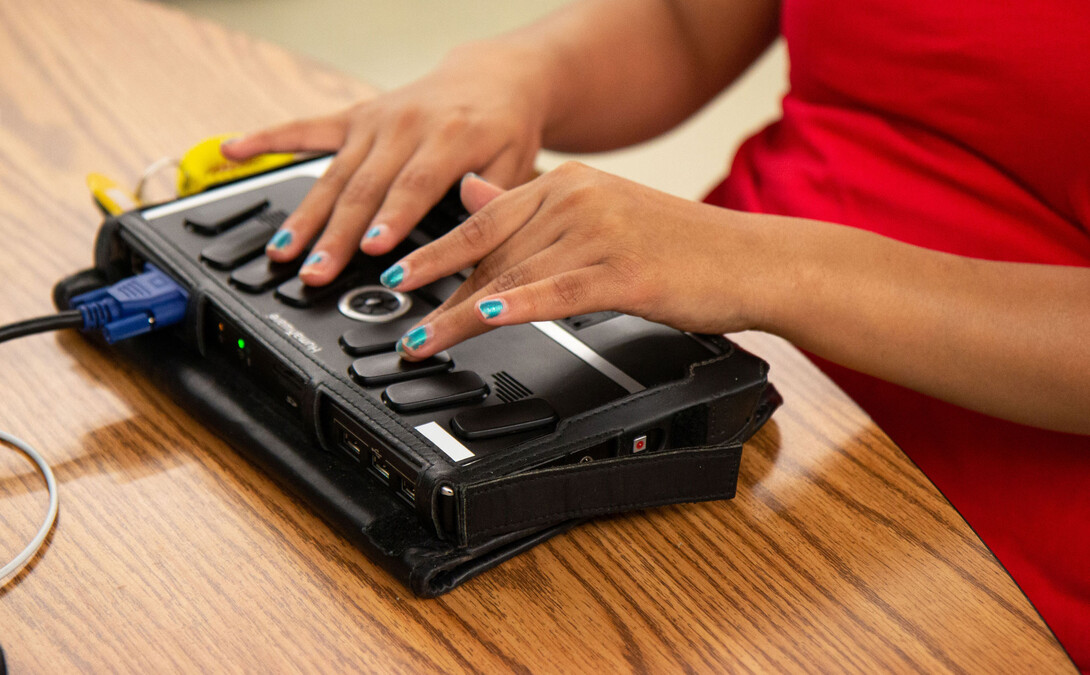
Nebraska researchers are working to better understand how students with visual impairments are being taught to write — and how that instruction can be tailored to each student’s needs.
Michael Hebert, associate professor of special education and communication disorders, and Mackenzie Savaiano, assistant professor of practice of special education and communication disorders, are the principal investigators for Project VIEW — Visual Impairments Education in Writing. The four-year study focuses on identifying factors that influence teachers’ writing instruction in an effort to improve outcomes among visually impaired students.
The Project VIEW team aims to study the modifications and accommodations that teachers make to their writing instruction for visually impaired students, as well as the collaboration among teachers of those students and their general education counterparts. The researchers will also examine how various factors — preparing to teach writing, preparing to teach students with visual impairments specifically, and beliefs and expectations — may influence student success.
Their goal is to better understand how these factors and teacher writing practices are associated with student achievement in writing, and to help design effective professional development interventions that will benefit teachers and administrators in Nebraska and beyond.
“We want to learn about what teachers are doing and identify things we can shape in the future,” Hebert said. “The goal is to help teachers further support students with visual impairments and empower them to express themselves through writing.”
Funded by a $1.4 million grant from the Institute of Education Sciences and housed at the Nebraska Center for Research on Children, Youth, Families and Schools, Hebert and Savaiano are recruiting 50 teachers of visually impaired students over four years — about 80% of them trained in Nebraska.
For each teacher of visually impaired students, they plan to recruit five general education teachers and five students with visual impairment. The first year’s study cohort will comprise eight teachers of visually impaired students, 40 general education teachers and 40 students with visual impairments. A different cohort will participate each year.
Students will include those who write using paper and pencil or Braille, as well as students with multiple disabilities who may use alternative writing tools.
Throughout the project, the team will gather data through interviews, surveys and classroom observations. It will also collect student writing assessments to examine whether teacher practices predict writing outcomes. After the surveys and interview protocols were developed, Hebert and Savaiano began working with Iowa teachers on a three-month pilot study to test and modify the measures.
In analyzing how teachers interact and work together to support students, Hebert and Savaiano said they hope to pinpoint the most effective instructional methods and determine which professional development opportunities would most benefit teachers.
“We are hoping to find pockets of really great things that are happening in schools across the state — things we think we replicate,” Hebert said. “We expect to find some great collaboration between teachers of visually impaired students and general education teachers that lead to innovative writing instruction for these students.”
Hebert recalls one such innovation that arose during a previous study. After they were asked to collect writing samples from students, many teachers working with visually impaired children or children with multiple disabilities reported that they were not doing writing instruction.
One teacher of visually impaired students, however, submitted a writing sample after working with a student who moved large-prints words around a smart board to construct sentences.
“That teacher was amazed,” Hebert said. “It was the first time the student had ever written anything to communicate. The student couldn’t write in Braille or use a pencil but was able to write in a way that made sense to him using that technology. So now, I think there is probably a lot of writing happening with that child that wasn’t happening previously.”
For Hebert, expanding perspectives on writing is a goal.
“Whether writing with paper and pencil, Braille, or dictating and orally constructing stories for other people to write, it’s still writing to communicate,” he said. “Speech-to-text software, moving words on a smart board — it can come in many forms. But it leads to the same result: allowing the student to record his or her thoughts in a form that can be read.”







